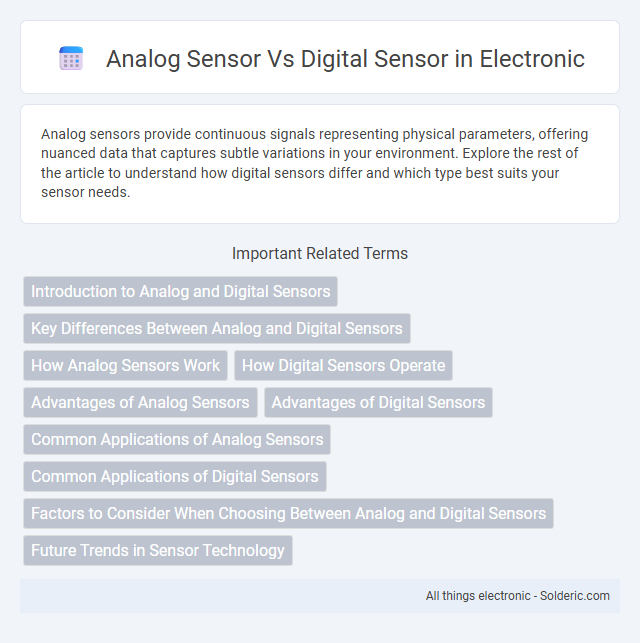Analog sensors provide continuous signals representing physical parameters, offering nuanced data that captures subtle variations in your environment. Explore the rest of the article to understand how digital sensors differ and which type best suits your sensor needs.
Comparison Table
| Feature | Analog Sensor | Digital Sensor |
|---|---|---|
| Signal Type | Continuous voltage or current | Discrete binary signals (0s and 1s) |
| Output | Variable continuous output | Fixed digital output |
| Precision | High resolution, prone to noise | Limited resolution, less noise |
| Interface | Analog-to-Digital Converter (ADC) required | Direct microcontroller interface |
| Complexity | Simple circuitry | More complex, integrated processing |
| Cost | Generally lower | Generally higher |
| Examples | Thermistor, photoresistor | Digital temperature sensor, motion sensor |
| Noise Immunity | Lower, susceptible to interference | Higher, better signal integrity |
| Data Processing | Requires external signal processing | Onboard processing capability |
Introduction to Analog and Digital Sensors
Analog sensors continuously measure physical quantities and convert them into variable voltage or current signals, allowing precise and real-time monitoring of parameters like temperature, pressure, or light intensity. Digital sensors output discrete binary signals representing specific states or values, facilitating easy interfacing with microcontrollers and digital systems. The choice between analog and digital sensors depends on the required data resolution, signal processing complexity, and application environment.
Key Differences Between Analog and Digital Sensors
Analog sensors produce continuous signals proportional to the physical measurement, allowing precise detection of varying values like temperature or pressure. Digital sensors output discrete signals, representing data as binary code, ideal for integrating with microcontrollers or digital systems. Your choice depends on whether you need detailed, real-time analog input or simplified, noise-resistant digital data for processing.
How Analog Sensors Work
Analog sensors detect continuous physical signals by converting variations in temperature, pressure, light, or other environmental factors into analog electrical signals, such as voltage or current. These sensors produce output signals that represent a range of values, enabling precise measurement of changing conditions in real time. Understanding how analog sensors work helps your system accurately interpret and respond to subtle variations in the environment.
How Digital Sensors Operate
Digital sensors operate by converting physical signals into discrete digital values using analog-to-digital converters (ADCs), enabling precise and noise-resistant data transmission. They measure parameters such as temperature, pressure, or light intensity, and output binary signals compatible with microcontrollers and digital systems. This digital output facilitates easy integration in embedded applications, providing consistent and reliable readings for real-time processing.
Advantages of Analog Sensors
Analog sensors offer continuous data output, providing more precise and detailed information about physical quantities like temperature, pressure, or light intensity. Their ability to capture subtle variations makes them ideal for applications requiring high-resolution measurements, such as environmental monitoring and medical devices. Your system benefits from analog sensors through simpler circuitry and compatibility with existing analog signal processing equipment.
Advantages of Digital Sensors
Digital sensors offer higher accuracy and noise immunity compared to analog sensors, making them ideal for precise measurements in complex environments. They provide easier integration with microcontrollers and digital systems through standardized communication protocols like I2C or SPI. Your projects benefit from improved data reliability and simplified calibration processes using digital sensor technology.
Common Applications of Analog Sensors
Analog sensors are widely used in applications requiring continuous measurement of physical quantities such as temperature, pressure, and light intensity, including industrial automation, environmental monitoring, and medical instrumentation. Their ability to provide variable output signals enables precise tracking of changes in real-time processes like fluid level detection and strain measurement. Common analog sensor types include thermocouples, potentiometers, and photodiodes, which are essential for capturing high-resolution, detailed data in control systems and sensor networks.
Common Applications of Digital Sensors
Digital sensors are widely used in applications requiring precise and noise-free data transmission, such as digital thermometers, motion detectors, and smart home devices. They excel in environments needing straightforward integration with microcontrollers and digital systems, including robotics, industrial automation, and IoT devices. The ability to provide discrete digital output simplifies data processing, enhances accuracy, and improves reliability in real-time monitoring and control systems.
Factors to Consider When Choosing Between Analog and Digital Sensors
When choosing between analog and digital sensors, key factors include the required signal resolution, noise susceptibility, and compatibility with processing systems. Analog sensors provide continuous data output ideal for precise measurements, while digital sensors offer discrete signals with built-in noise immunity and easy integration with microcontrollers. Environmental conditions, power consumption, and response time also influence the decision, with digital sensors generally favored for robust, low-power applications.
Future Trends in Sensor Technology
Future trends in sensor technology emphasize increased integration of analog and digital sensors for enhanced precision and real-time data processing. Analog sensors provide continuous, high-resolution signals, while digital sensors offer noise immunity and ease of data transmission, enabling more accurate monitoring in IoT and smart devices. Your choice of sensors will benefit from advancements like AI-driven calibration and low-power designs, optimizing performance in diverse applications.
analog sensor vs digital sensor Infographic

 solderic.com
solderic.com